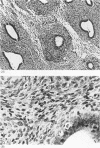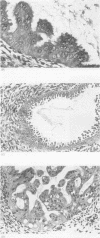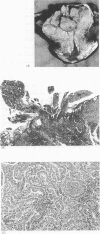Abstract
AIMS--To determine the type of endometrial abnormalities associated with prolonged tamoxifen treatment and to investigate the correlation between tamoxifen dose and any abnormalities detected. METHODS--Endometria from 19 prospectively collected breast cancer patients treated with tamoxifen were ascribed a pathological diagnosis and the findings compared with those in a control group matched for age and presentation. The abnormalities were related to cumulative tamoxifen dose. RESULTS--The two asymptomatic treated patients had generalised simple endometrial hyperplasia at necropsy. No endometrial abnormalities were seen at necropsy in the two control cases. Of the 17 patients treated with tamoxifen who underwent surgery for gynaecological symptoms, 11 had hyperplastic endometrial polyps characterised by epithelial metaplasias and patchy periglandular condensation of stroma. Two women had primary endometrial malignancies with myometrial invasion, and three women, one of whom had previously presented with a benign polyp, had an endometrial polyp-cancer on a background of hyperplasia. Endometrial malignancies were confined to women who had taken more than 35 g of tamoxifen. The control group included no endometrial polyp-cancers, only one patient with an endometrial polyp, four women with endometrial hyperplasia and four with primary endometrial malignancy. CONCLUSIONS--These findings support a link between prolonged tamoxifen treatment and endometrial malignancy and identify a subgroup of patients--that is, those who have taken more than 35 g of tamoxifen, who may be at increased risk of endometrial cancer. The spectrum of pathological findings in patients treated with tamoxifen suggests that the drug promotes endometrial growth and that endometrial polyps may be an important intermediate step in endometrial carcinogenesis.
Full text
PDF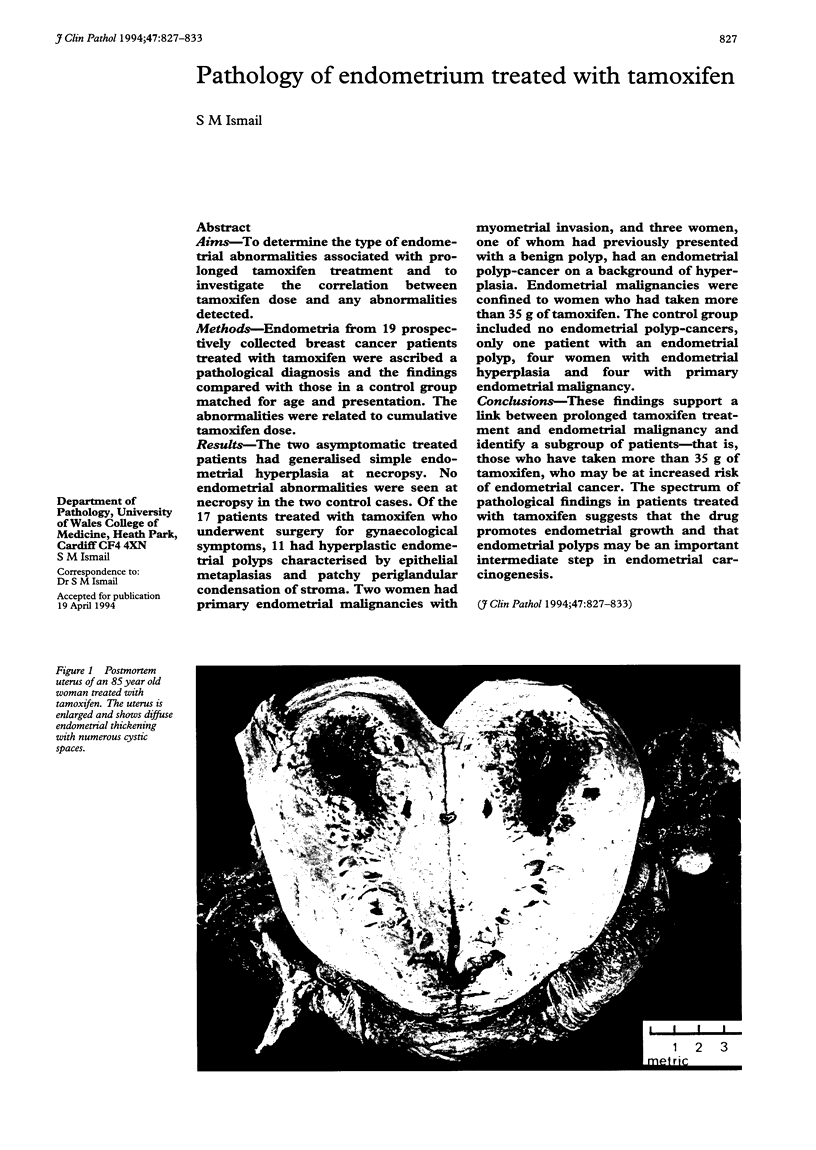
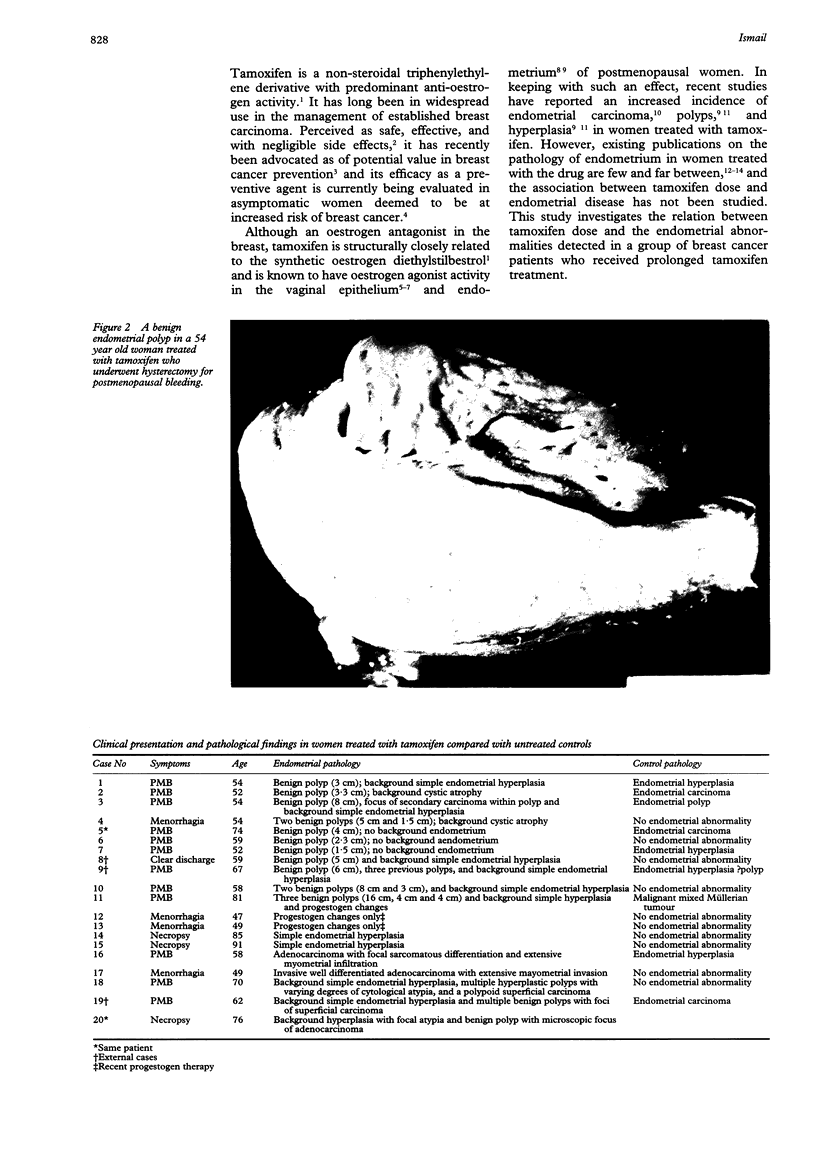
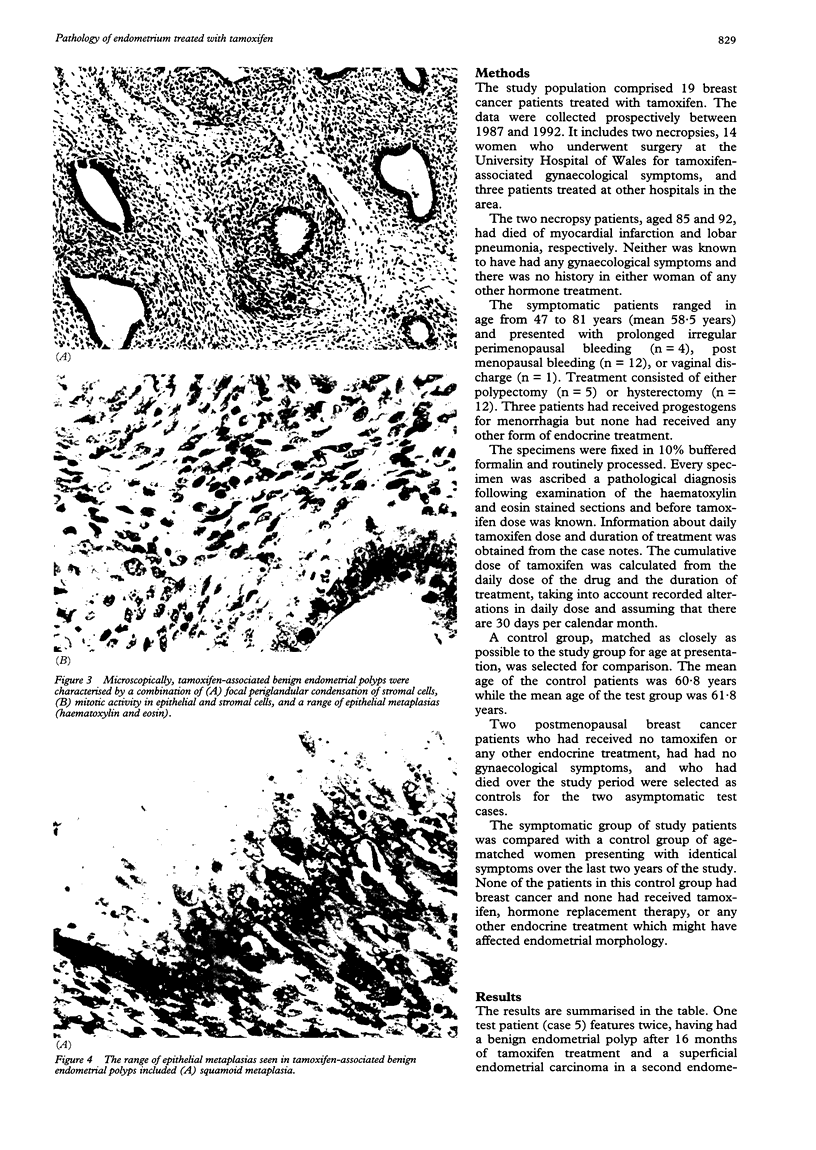
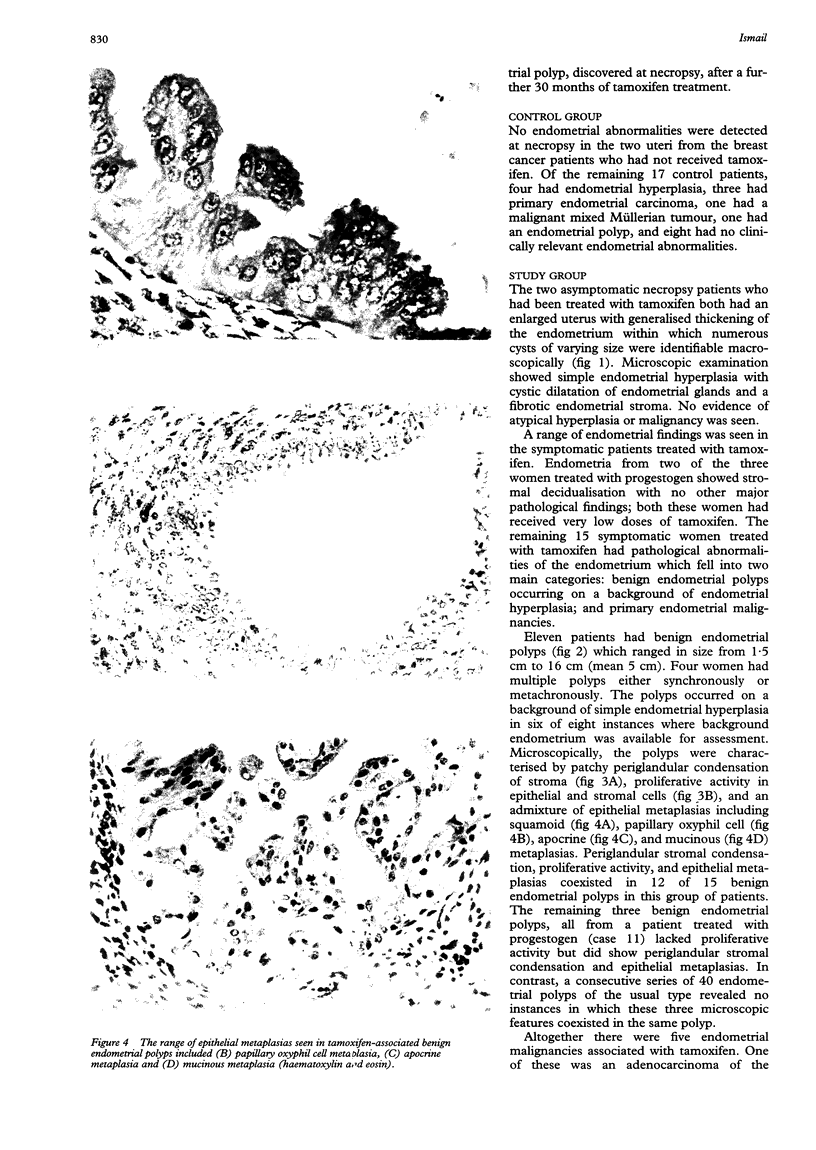
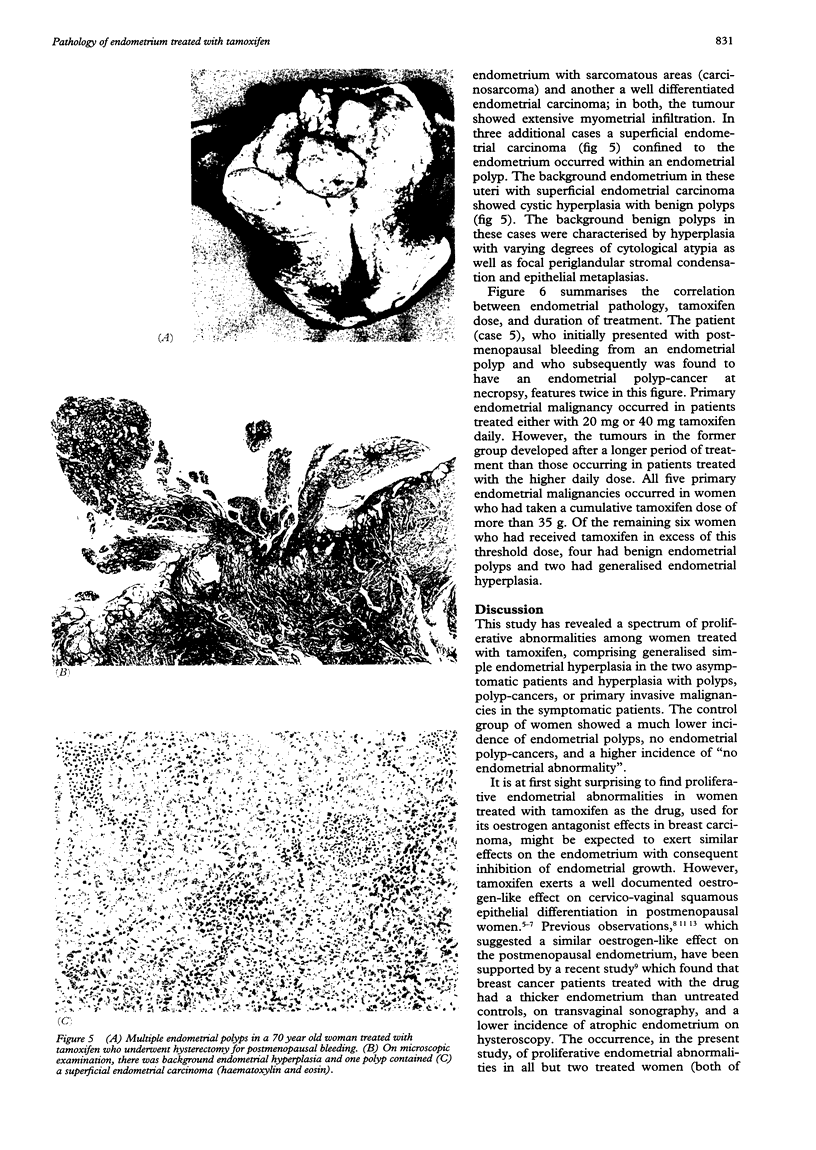
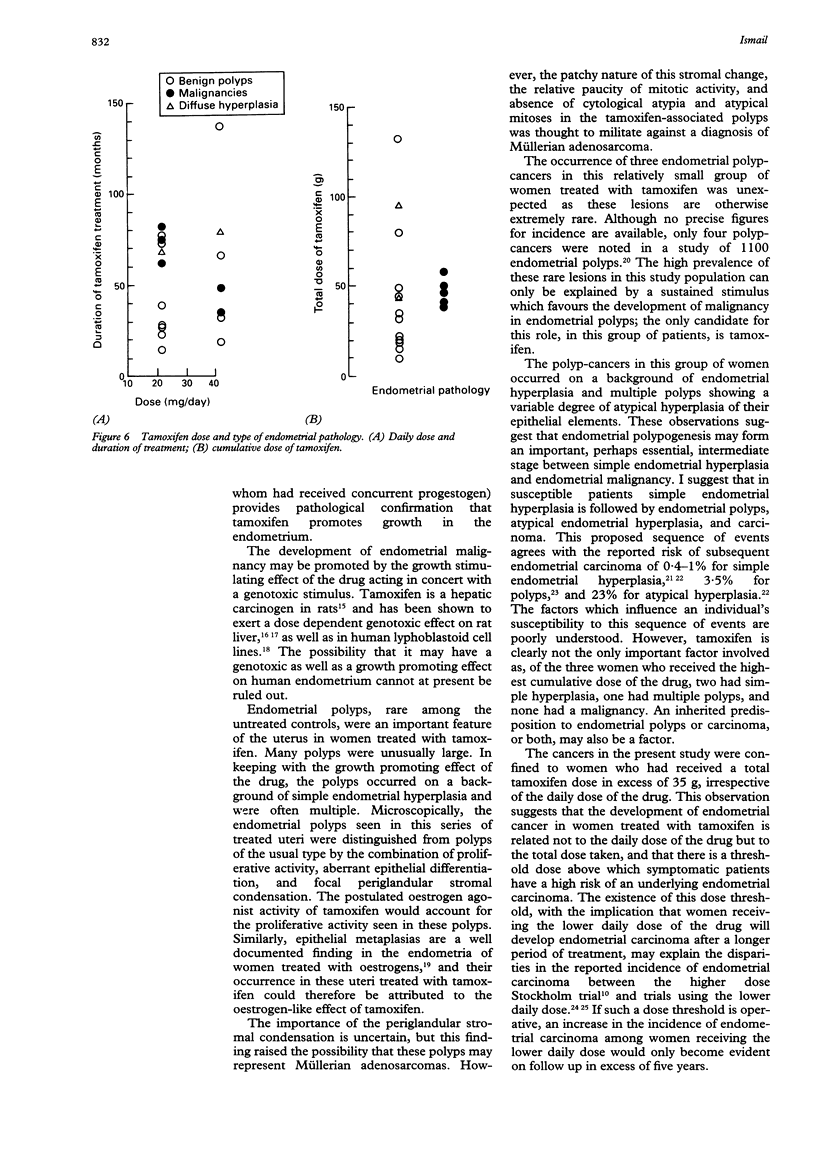
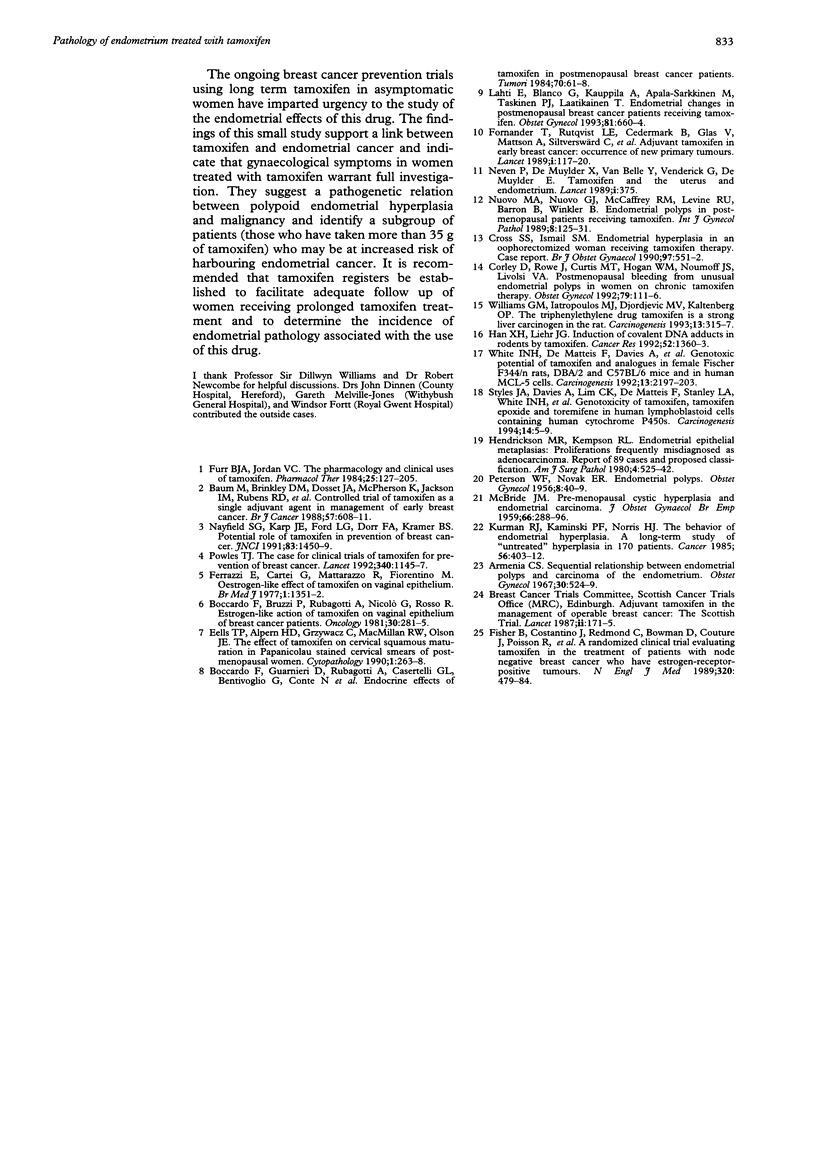
Images in this article
Selected References
These references are in PubMed. This may not be the complete list of references from this article.
- Armenia C. S. Sequential relationship between endometrial polyps and carcinoma of the endometrium. Obstet Gynecol. 1967 Oct;30(4):524–529. [PubMed] [Google Scholar]
- Boccardo F., Guarneri D., Rubagotti A., Casertelli G. L., Bentivoglio G., Conte N., Campanella G., Gaggero G., Comelli G., Zanardi S. Endocrine effects of tamoxifen in postmenopausal breast cancer patients. Tumori. 1984 Feb 29;70(1):61–68. doi: 10.1177/030089168407000110. [DOI] [PubMed] [Google Scholar]
- Controlled trial of tamoxifen as a single adjuvant agent in the management of early breast cancer. 'Nolvadex' Adjuvant Trial Organisation. Br J Cancer. 1988 Jun;57(6):608–611. doi: 10.1038/bjc.1988.138. [DOI] [PMC free article] [PubMed] [Google Scholar]
- Corley D., Rowe J., Curtis M. T., Hogan W. M., Noumoff J. S., Livolsi V. A. Postmenopausal bleeding from unusual endometrial polyps in women on chronic tamoxifen therapy. Obstet Gynecol. 1992 Jan;79(1):111–116. [PubMed] [Google Scholar]
- Eells T. P., Alpern H. D., Grzywacz C., MacMillan R. W., Olson J. E. The effect of tamoxifen on cervical squamous maturation in Papanicolaou stained cervical smears of post-menopausal women. Cytopathology. 1990;1(5):263–268. doi: 10.1111/j.1365-2303.1990.tb00359.x. [DOI] [PubMed] [Google Scholar]
- Ferrazzi E., Cartei G., Mattarazzo R., Fiorentino M. Oestrogen-like effect of tamoxifen on vaginal epithelium. Br Med J. 1977 May 21;1(6072):1351–1352. doi: 10.1136/bmj.1.6072.1351-e. [DOI] [PMC free article] [PubMed] [Google Scholar]
- Fisher B., Costantino J., Redmond C., Poisson R., Bowman D., Couture J., Dimitrov N. V., Wolmark N., Wickerham D. L., Fisher E. R. A randomized clinical trial evaluating tamoxifen in the treatment of patients with node-negative breast cancer who have estrogen-receptor-positive tumors. N Engl J Med. 1989 Feb 23;320(8):479–484. doi: 10.1056/NEJM198902233200802. [DOI] [PubMed] [Google Scholar]
- Fornander T., Rutqvist L. E., Cedermark B., Glas U., Mattsson A., Silfverswärd C., Skoog L., Somell A., Theve T., Wilking N. Adjuvant tamoxifen in early breast cancer: occurrence of new primary cancers. Lancet. 1989 Jan 21;1(8630):117–120. doi: 10.1016/s0140-6736(89)91141-0. [DOI] [PubMed] [Google Scholar]
- Furr B. J., Jordan V. C. The pharmacology and clinical uses of tamoxifen. Pharmacol Ther. 1984;25(2):127–205. doi: 10.1016/0163-7258(84)90043-3. [DOI] [PubMed] [Google Scholar]
- Han X. L., Liehr J. G. Induction of covalent DNA adducts in rodents by tamoxifen. Cancer Res. 1992 Mar 1;52(5):1360–1363. [PubMed] [Google Scholar]
- Hendrickson M. R., Kempson R. L. Endometrial epithelial metaplasias: proliferations frequently misdiagnosed as adenocarcinoma. Report of 89 cases and proposed classification. Am J Surg Pathol. 1980 Dec;4(6):525–542. [PubMed] [Google Scholar]
- Kurman R. J., Kaminski P. F., Norris H. J. The behavior of endometrial hyperplasia. A long-term study of "untreated" hyperplasia in 170 patients. Cancer. 1985 Jul 15;56(2):403–412. doi: 10.1002/1097-0142(19850715)56:2<403::aid-cncr2820560233>3.0.co;2-x. [DOI] [PubMed] [Google Scholar]
- Lahti E., Blanco G., Kauppila A., Apaja-Sarkkinen M., Taskinen P. J., Laatikainen T. Endometrial changes in postmenopausal breast cancer patients receiving tamoxifen. Obstet Gynecol. 1993 May;81(5 ):660–664. [PubMed] [Google Scholar]
- McBRIDE J. M. Pre-menopausal cystic hyperplasia and endometrial carcinoma. J Obstet Gynaecol Br Emp. 1959 Apr;66(2):288–296. doi: 10.1111/j.1471-0528.1959.tb02009.x. [DOI] [PubMed] [Google Scholar]
- Neven P., De Muylder X., Van Belle Y., Vanderick G., De Muylder E. Tamoxifen and the uterus and endometrium. Lancet. 1989 Feb 18;1(8634):375–375. [PubMed] [Google Scholar]
- Nuovo M. A., Nuovo G. J., McCaffrey R. M., Levine R. U., Barron B., Winkler B. Endometrial polyps in postmenopausal patients receiving tamoxifen. Int J Gynecol Pathol. 1989;8(2):125–131. doi: 10.1097/00004347-198906000-00005. [DOI] [PubMed] [Google Scholar]
- PETERSON W. F., NOVAK E. R. Endometrial polyps. Obstet Gynecol. 1956 Jul;8(1):40–49. [PubMed] [Google Scholar]
- Powles T. J. The case for clinical trials of tamoxifen for prevention of breast cancer. Lancet. 1992 Nov 7;340(8828):1145–1147. doi: 10.1016/0140-6736(92)93162-g. [DOI] [PubMed] [Google Scholar]
- Styles J. A., Davies A., Lim C. K., De Matteis F., Stanley L. A., White I. N., Yuan Z. X., Smith L. L. Genotoxicity of tamoxifen, tamoxifen epoxide and toremifene in human lymphoblastoid cells containing human cytochrome P450s. Carcinogenesis. 1994 Jan;15(1):5–9. doi: 10.1093/carcin/15.1.5. [DOI] [PubMed] [Google Scholar]
- White I. N., de Matteis F., Davies A., Smith L. L., Crofton-Sleigh C., Venitt S., Hewer A., Phillips D. H. Genotoxic potential of tamoxifen and analogues in female Fischer F344/n rats, DBA/2 and C57BL/6 mice and in human MCL-5 cells. Carcinogenesis. 1992 Dec;13(12):2197–2203. doi: 10.1093/carcin/13.12.2197. [DOI] [PubMed] [Google Scholar]
- Williams G. M., Iatropoulos M. J., Djordjevic M. V., Kaltenberg O. P. The triphenylethylene drug tamoxifen is a strong liver carcinogen in the rat. Carcinogenesis. 1993 Feb;14(2):315–317. doi: 10.1093/carcin/14.2.315. [DOI] [PubMed] [Google Scholar]





